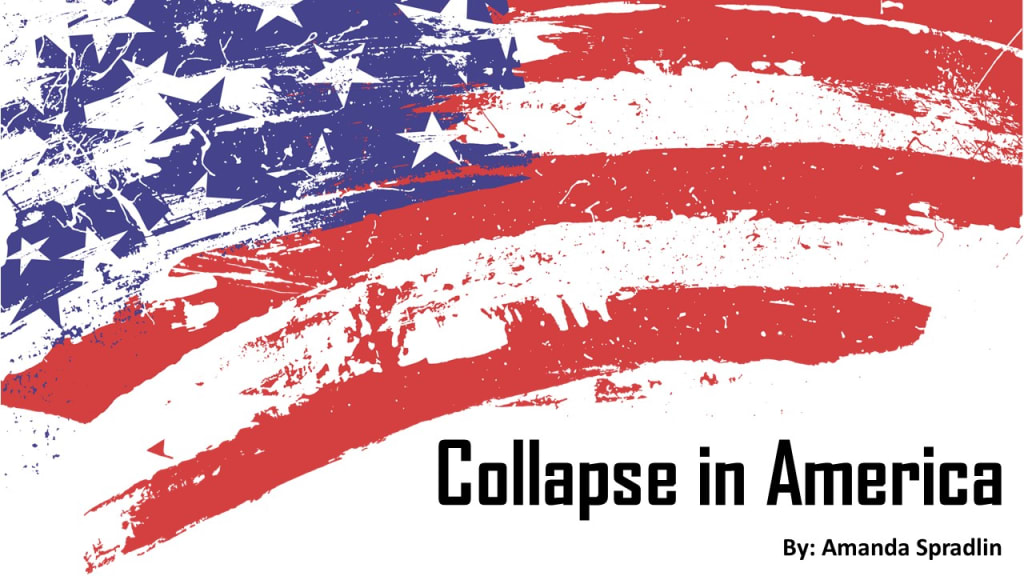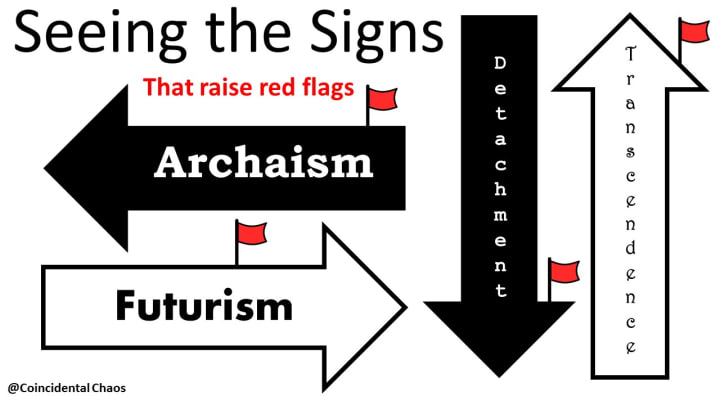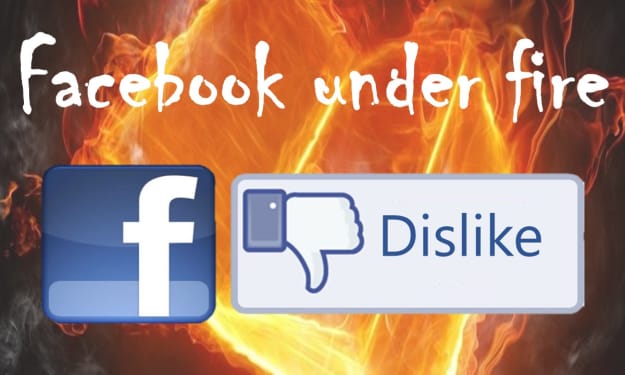Collapse in America
“American civilization, as we know it, is on the cusp of collapse.”

Recently, the Bulletin of the Atomic Scientists just released the time on the Doomsday clock which reads, “It is 100 Seconds to Midnight,” right now in 2021. This theoretical visualization of the existential threat to society and the world is intended to urge action and encourage safety and prevention. Will this generation see Doomsday? Are we safe? This report aims to take an objective look, all around, at the current challenges we face today by examining history and research.
The adage, “history repeats itself,” is of great assistance in finding common denominators among the sprawl and the eventual fall of a diverse chronicle of civilizations. Social scientist at Cambridge University, Luke Kemp, surveyed the longevity of ancient civilizations from 3000 B.C.E. to 600 C.E. and found that the average lifespan of any civilization is about 340 years (Kemp, 2019). To define a civilization, Kemp included any populated settlement that had its own form of governance, military, and agriculture. Incorporating Kemp’s findings and applying them to today’s most recent civilizations, I have established a basic timeline to depict and highlight where the United States of America came from, where it stands, and where it may be headed.

1150 C.E. Pre-Colombian Era
Ancient civilizations of Native American Indians occupied the Americas from at least about 1150 C.E. This timeline begins here because it signifies the rise and fall of the Toltec society, as well as the formation of a dominate minority that would go on to later become the Aztec civilization (Cartwright, 2018). The rise of the Toltec society is attributed to their success in conquest and capabilities of trade. The fall of the Toltec society remains up for debate, but theories suggest that it succumbed to civil war, agricultural and commercial problems, and overpopulation due to high migration. Despite conflicting perspectives, it is certain through archaeological findings that the capitol city of the Toltecs, Tollan, was destroyed violently around 1150 C.E. Correspondingly, this indicates the collapse of the civilization. The dominate minority of Toltec people that remained after the fall of their society then began the move north through Mexico, with artifacts evident of migration being dated, arguably 1156 or 1168.
1492 C.E. Doctrine of Discovery
The voyage and conquest of Christopher Columbus in 1492 was a major event that greatly changed the course of American history. Although the land was densely inhabited by several Native American Indian tribes throughout the continents by this time, a decree entitled, the “Doctrine of Discovery” issued by Pope Alexander VI in 1493 permitted the Spaniards to acquire any land it may find in its journey, with the goal of spreading the Catholic faith (gilderlehrman.org). This set the standard foundation of implementing a new ideology among the people. The Spaniards used this doctrine as permission and justification to claiming sovereignty to land that the Natives had already occupied for hundreds of years. Ultimately, the acquisition birthed British colonization of American land and the societal assimilation of Native American Indians.
1776 C.E. Declaration of Independence
The Declaration of Independence is the next major turning point in history that has impacted today’s American society, as it marks the severance of American colonies from Great Britain (archives.gov). This declaration was the first of three founding documents that would become known as the Charters of Freedom. Together, they outline a differentiation in ideology, the framework for federal government, and the rights of citizens and states. The belief systems and laws of the land that we currently live by today are detailed within the contents of these documents. They have been used as reference to interpret justice and to guide the ideals and behavior of American society for nearly 250 years.
Where We Stand
The millennium marked a huge change in the way of American life. Society has continued to experience rapid growth and progressive pressure under the immense expansion and implementation of technology throughout civilization. Cancel culture has grown like wildfire and the dilution of American democracy has been front and center as the political spectacle of the world. The Internet of Things demonstrates a connected network of the world on a global level and is symbolic of a digital sense of unity among the human species on Earth (Morgan, 2014). However, it seems to have left us more disconnected from one another more than ever before, especially in times of high stress and controversy. The worldwide web has created a platform of entanglement that converges upon all civilizations of the globe, calling for a collective alliance to be formed as coexistent citizens of the planet. The lens of Americans has been widened in such a way that we now see ourselves in retrospect of everyone else on a much broader scale.
Identified Existential Threats
There are many existential threats facing American civilization today. As explained in depth by the Bulletin of the Atomic Scientists, the two main threats mankind is up against are nuclear war and climate change (Spinazze, 2021). These threats are fueled by cyber-enabled information warfare and further strengthened by the deterioration of the political structures meant to mitigate them. Along with the United States, Russia and China are also two major civilizations currently experiencing political conflict, respectively within their own countries. Simultaneously, we are all scrambling to compete in an outlandish nuclear arms race to modernize our weapons of mass destruction. Overall, this significantly increases the worldwide potential risk of nuclear war. Climate change is deeply impacted by the use of fossil fuels. Human activities have gradually depleted the earth’s natural resources, greatly effecting the economy, culture, society, and the ecology of existential life. Disease outbreaks and other natural disasters only compliment these catastrophic, key contributors to societal collapse.

Unfortunately, America seems to fit each of the suggested models of societal collapse, at the present time (Tainter, 1990):
- The Dinosaur model – A large society that exhausts its resources too quickly, with leaders unwilling to adapt to a more sparing usage rate before it is too late.
- The Runaway Train model – A society that is dependent upon continued growth. Once all challenges are overcome and all conquests achieved, the need for a distinguished society diminishes, no longer serving a purpose.
- The House of Cards model – A society so complex with the development of subordinate institutions that it increasingly becomes unstable, leading to an ultimate collapse.
As far as America is concerned, the shoe of the dinosaur fits as we struggle to preserve petroleum and precious minerals. The runaway train is relatable, as it seems we have reached a ceiling in what used to be considered the American Dream. The house of cards is where we seem to currently reside among our civil political challenges. The emergence of radicals and extremists have protruded into traditional American democracy, which has historically been comprised of a two-party majority system, encouraging political dissent and societal subversion. No matter which model is applied to modern America, each can be related to our current reality.
Signs of Societal Collapse
The decay of a civilization can also be identified through specific behaviors that can be observed throughout society (Kumar, 2014). When a civilization is crumbling, the fall distinguishes a dominant minority that creates what is called a universal state. This was demonstrated by the Toltec’s when they regrouped and moved forward to become the Aztecs. In this type of environment, research shows that people tend to resort to 1 or more of 4 categorical behaviors: archaism, futurism, detachment, and transcendence.

The recent rise of witchcraft and occultism is a direct connection to archaism and the ideals of the past (Bosker, 2020). Consequentially, this could be caused by increased instability combined with dwindling confidence in political systems and governmental establishments. Evidenced by the Salem witch trials of 1692, witchcraft was considered a capital crime in British colonies under English Law (Linder, 2021). Although all prisoners were released by May of 1693, it took until 1702 for the court to officially deem the trials unlawful. Then, another 9 years passed before a legislative bill was adopted in 1711 to formally give the accused their rights back as citizens and rectify their public reputations.
Futurism can clearly be derived from this historical context as well. The Salem witch trials pre-date the Declaration of Independence. During this time, the ideology of society was stirring within American colonies, leading to a pursuit of independence and a shift away from political and social ties with Great Britain. As confidence in the establishment declined and instability among the colonies increased, the founding fathers united the colonies together as one nation by forming its own dominant minority government body, the Continental Congress, which ultimately led to the American Revolution. Therefore, the futurists of that timeframe were, in fact, our current civilization’s founding fathers. To compare, the futurists of today could be those committed to progressive movements, exemplified by independent entities such as the Berggruen Institute (berggruen.org).
Detachment of this time is also no different than what can be seen today. Surely, there were many people who tried to ignore the happenings of the Salem witch trials out of fear for their own well-being. On the other hand, there were also people who defended them without hesitation. These are both forms of detachment as they go against the social norms of conformity and obedience. Today, the rise of extremist groups and radicals have been on the rise, right along with witchcraft, occultism, fact-checker’s, and conspiracy theorists. These are all forms of detachment.
Transcendence can be understood as meeting the challenges of civilization with new insight, in a way such as a prophet, with strong faith in a higher power. Historically, this was observed in the 1700’s with the Enlightenment movement, followed by First Great Awakening which revived religion across the American colonies throughout the 1730’s and 1740’s (history.com). Correspondingly, in today’s civilization we are seeing a quick rise in spirituality over religion. According to Pew Research Center, over 25% of Americans today identify as being spiritual but not religious (Young & Miller-Medzon, 2020). In addition, global research firm, YouGov, determined that “becoming more spiritual” was among the top 10 new year’s resolutions for 2020. Interest has also grown substantially in the areas of metaphysics and holistic therapeutics such as yoga, meditation, the application of vibrational frequencies, balancing of chakras, aromatics, herbal remedies, and crystal healing.
What does this all mean?
These are the unavoidable signs that American civilization, as we know it, is on the cusp of collapse. The events that are currently transpiring are indicative of times changing and society shifting, as relative to the most previous course of American history. While challenging, it may not be a bad thing. We need to address our adversities to achieve sustainability as a highly intelligent species on this one single planet we all must share. We should use our brains to form bonds and our humanity to heal. Being kind, courteous, and compassionate could develop kinship and establish a common respect and understanding for one another. Instead of implementing another varied form of affirmative action that is condescending and only underlines our differences, we should come together in altruistic acceptance to emphasize our shared goal; to survive and thrive as cohabitants of this Earth for centuries to come.
References
Archives.gov. “America’s Founding Documents”. https://www.archives.gov/founding-docs
Berggruen.org. 2021. “Ideas for a Changing World”. https://www.berggruen.org/about/
Bosker, Bianca. Mar 2020. “Why Witchcraft Is on the Rise”. https://www.theatlantic.com/magazine/archive/2020/03/witchcraft-juliet-diaz/605518/
Cartwright, Mark. Apr 27, 2018. “Toltec Civilization”. https://www.ancient.eu/Toltec_Civilization/
History.com Editors. Sept 20, 2019. “Great Awakening”. https://www.history.com/topics/british-history/great-awakening#:~:text=culture%20at%20large.-,First%20Great%20Awakening,the%20world%2C%20while%20downplaying%20religion.
Kemp, Luke. Feb 19, 2019. “In the graphic below, the University of Cambridge’s Luke Kemp compiled a list of civilisations to compare how long they lasted”. https://www.bbc.com/future/article/20190218-the-lifespans-of-ancient-civilisations-compared
Kumar, Krishan. Oct 3, 2014. "The Return of Civilization—and of Arnold Toynbee?". Comparative Studies in Society and History. 56 (4): 815–843. doi:10.1017/S0010417514000413.
Linder, Douglas. 2021. “Chronology of Events Relating To The Salem Witchcraft Trials”. https://famous-trials.com/salem/2075-asal-ch
Morgan, Jacob. May 13, 2014. “A Simple Explanation Of 'The Internet of Things'”. https://www.forbes.com/sites/jacobmorgan/2014/05/13/simple-explanation-internet-things-that-anyone-can-understand/?sh=7a754881d091
Pope Alexander VI, 1493. “The Doctrine of Discovery”. https://www.gilderlehrman.org/history-resources/spotlight-primary-source/doctrine-discovery-1493.
Spinazze, Gayle. Jan 23, 2021. “It is now 100 seconds to midnight.” https://thebulletin.org/2020/01/press-release-it-is-now-100-seconds-to-midnight/
Tainter, Joseph (1990), The Collapse of Complex Societies (Cambridge University Press) pp. 59-60.
Young, Robin & Miller-Medzon, Karen. Jan 13, 2020. “Can Spirituality Exist Without God? A Growing Number Of Americans Say Yes”. https://www.wbur.org/hereandnow/2020/01/13/spirituality-krista-tippett
About the Creator
Amanda Spradlin
Amanda Spradlin is the founder of Coincidental Chaos. She writes with the passion of a questionable mind. Any donations are appreciated!






Comments
There are no comments for this story
Be the first to respond and start the conversation.